
VERDON TOWNSHIP, MINNESOTA


EXCERPT FROM "BEYOND THE CIRCLE"
by Leo Trunt
Published with Permission of the Author
Transcribed by Karen Klennert
For Purchasing Information, Contact Leo Trunt

The area now known as Verdon Township has a history that goes back many years. Indian peoples traveled the Mississippi River through the township for eons. Pokegama Creek undoubtedly got its name from them, and the namesake was handed down to the present day. Because of the many spearheads, arrowheads, and other relics found there, there is thought to be an old Indian camp or village located near the mouth of Two River Creek.

EARLY MAP OF VERDON TOWNSHIP, 1875
Courtesy Louise Trygg, from the J. W. Trygg Collection
The early fur traders paddled through Verdon and made their way along the river. An ancient cooking stove was found some distance south of Two River Creek that may have come from an old trapper's cabin. "On top of a high hill near the Mississippi River many years ago, a tamarack pole could be seen tacked high up in a huge old red oak tree. No one examined it until years later, when the wind blew the tree down. Then the tacks, which were about four inches apart, a distance of about six feet on the pole, were pried out. These were large headed square tacks and under each were bits of cloth, no doubt the remains of a flag of some sort, probably put there by French explorers or perhaps Henry Schoolcraft. No one knows of course. The pole itself had been nailed to the tree with ancient looking spikes." (Aitkin County Heritage, page 26, 1991)
In the 1870's, the early loggers came upon the scene. They first logged along the Mississippi River and perhaps to a distance of a few miles away from the river. The logs were skidded to the river and floated down to the sawmills in Minneapolis and other points south. Two Rivers Creek, in the southern part of the township, has the remains of two logging camps on its banks and three dams which were built by the loggers in their efforts to raise the water level enough to run the logs down the stream. (Ibid)

LOG DRIVE ON THE WILLOW RIVER
IN WESTERN VERDON TOWNSHIP, 1910
Pictured: Willet Weston, Hiram Weston, Ed Roberts, Unknown
Courtesy of Ruth Larson ~ Photo by J. W. Sarff
Dick Wiggins was an early river driver. He worked the river drives with his brother Lyle, and also worked at Grand Rapids at the boom where they pushed the logs over the dam. When asked why he was called a "River Pig", Dick responded, "I think it's because we were always covered with mud. My brother Lyle and I used to play on the logs on the river. We got pretty good on those logs." (Interview of Dick Wiggins by Larry Luukkonen, Aitkin Age ~ September 28, 1983)

EARLY RIVER DRIVERS ON THE MISSISSIPPI RIVER
IN VERDON TOWNSHIP, 1920
Pictured: Lyle Wiggins, Bill Wiggins Sr., Dick Wiggins
Courtesy of Walter Schularick
Dick Wiggins eventually went into farming. It was a common practice to cut hay on the meadows of the Willow River in those days. Dick relates, "I took my team of oxen out to make hay one real hot day. We went out to the Willow River which was about three miles away. As we would be gone all day, we would take out lunch along. When we got closer to the river, I ordered the oxen to stop. They kept on going right into the drink and everything went with them. There were loaves of bread floating all over the river!" (Interview of Dick Wiggins by Larry Luukkonen, Aitkin Age ~ October 12, 1983)
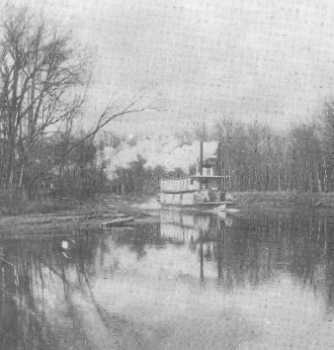
THE "ORIOLE" ~ A STEAMBOAT ON THE MISSISSIPPI RIVER
IN VERDON TOWNSHIP, 1909
Courtesy of Walter Schularick
The 1870's also saw the advent of the steamboats on the Mississippi River. Steamboats became one of the better ways of getting around in Verdon Township. They started plying the waters in the 1880's and ran until about 1920. At times though, the steamboats were fraught with danger. Mishaps did occasionally occur as one newspaper account relates. "A telephone message from Sandy Lake by way of McGregor yesterday morning to Captain Viebahn of the transportation company stated that the steamer Irene had gone to the bottom of the river near Verdon Sunday. She went up to Sandy Lake Friday to haul some lumber for the government dam work and it is not known how the accident happened. The boat was expected to arrive here Saturday night or Sunday. Captain Viebahn went up river yesterday by team to see about raising the sunken craft." (Aitkin Age ~ May 19, 1908) After that, Harry Riggs ran a boat to ferry people to Big Sandy or up to Jacobson. The mail was also brought down in his boat. There was a rapids in the center of the township that was known as "Crooked Rapids." Often times the steamboat could not get past this rapids and was forced to turn around when the water was low. In the early years, the area was referred to by the name of Crooked Rapids.

THE "BLUE BELL," HARRY RIGGS'
MAIL & EXCURSION BOAT, 1915
Courtesy of Don Wells
One of the early settlers was Emery Wells, who came into the area in 1898. He built a big house that was used as a stopping place for weary travelers. The basement was made with cement with rocks placed in it. Rooms were rented out to a number of loggers over the years. There was a good business for this stopping place at first, but Emery had only caught the tail end of the logging era and soon his business diminished. Once in a while a traveling minister would stop by and services were held in the house.
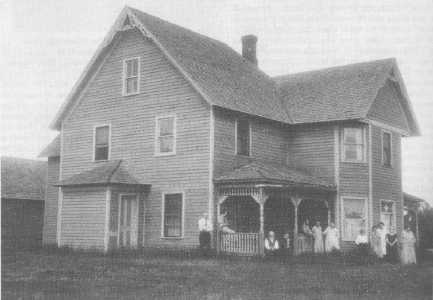
E. B. WELLS HOUSE IN VERDON TOWNSHIP, 1925
Courtesy of Don Wells
Emery Wells had built a good sized sawmill on his place. Don Wells was the fireman and the official steam engineer for the mill. The mill used slabs as fuel for the boiler. (Interview with Don Wells ~ December 6, 1995) One time a man got hurt quite badly at the mill. Andrew Devine met with a very serious accident last Thursday at the Verdon sawmill. While sawing slabs his coat caught in the saw, drawing in his right arm which was almost completely severed at the elbow. His arm was also badly torn. Devine displayed a brand of courage that won the admiration of the men at the mill. Jerking his arm free of the saw he walked to the other side of the mill and the injured member was cared for by the crew. He was then put into William Riggs' launch and hurried to Palisade in an effort to catch the Soo passenger for Superior, but missed it by a few minutes. An extra freight came along and the injured man was placed on board. A clear track was given the freight and a remarkably fast run was made to Superior where Devine was rushed to St. Mary's hospital where he received the proper care. R. W. Greenwood, who accompanied Devine to Superior, returned Sunday and reported that the injured man was doing nicely." (Hill City News ~ September 26, 1912) Wells sawed lumber for the area farmers or would sell lumber to whoever needed it. The mill ran until 1930 and eventually was sold for scrap metal during World War II.

VERDON MILL AND LUMBER COMPANY ADVERTISEMENT
The print on the left gives the officers of the business.
The print on the right says, "We have a large amount of farm and meadow land FOR SALE."
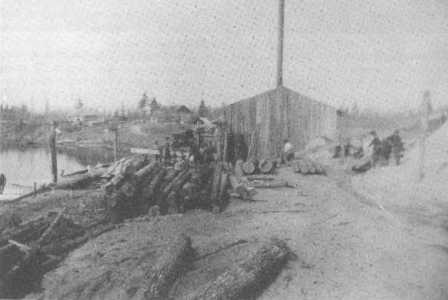
E. B. WELLS STEAM SAWMILL, 1903
Courtesy of Don Wells
Emery's son Lloyd had land on both sides of the Mississippi River. His house was on the west side while his pasture and hay lands were on the east side. This made for many crossings throughout the year. "In the winter we used to take a team across the river and bring hay over to our farm buildings that were on the west side. In the summer, we would get in a row boat and tie a rope over the head of a team and lead them across to the east side. I went to school at the Barton School and so I had to cross the river to get there. In the winter I would walk across the ice using cross country skis. In the spring, when the ice would get thinner, Dad would put planks across the ice for me to walk on. Then the ice would go out, and I would have to use a boat. In the fall, I would use a boat until the ice was strong enough to walk on. It seems strange, but I don't recall ever missing any school, so the ice must have gone out on the weekends." (Interview with Don Wells ~ December 6, 1995) Lloyd Wells did some river driving, and he was also the local blacksmith for the farmers. Another settler was Aldro Barton who came in 1901 with his father Fred Barton.

MAMIE AND POLLY WIGGINS ON HOMEMADE SKIS, 1912
Courtesy of Walter Schularick
Verdon Township and post office had gotten its name from Verdon Wells, son of Emery B. Wells. (Minnesota Geographic Names, by Warren Upham) The post office was organized on April 16, 1901, with Emery B. Wells as the first postmaster. On May 6, 1918, Addie Riggs took over. Rose Riggs took charge on October 6, 1919.
Verdon Township was organized on January 3, 1903. The township set up a cemetery early on. It is thought there might have originally been a few Indian burials there. The first known intern was Perry "King" Newell, a lumberjack who met some misfortune and was buried there in 1903. The original caretaker kept most of the records in his head, which were lost forever when he passed away. There were a few written records, but these were destroyed when the caretaker's house burned. Many years later in 1977, a few plain white wooden crosses were erected by the Verdon 4-H group who cleaned up the cemetery after it had grown up with brush. The crosses mark no particular grave as the names are not known. (Aitkin Age ~ 1977)
The dredges came through Verdon Township in 1910. They were dredging the Willow River, and a number of sections were dredged in the western part of the township. It had been hoped the dredges would put that part of the township into the agriculture business. There were roads built upon the ditch banks, and for a time, it seemed there was some promise to the area. Alas, it was not to be. The land remained wet and refused to cooperate with even the hardiest of farmers. One dredge was left behind for some reason, and the remains of it are still there in the southeastern corner of section 6.

FIRST ROAD UNDER CONSTRUCTION IN VERDON TOWNSHIP
NEAR RAY BARTON'S PLACE, 1920
Ed Wells is on the tractor
Lloyd Wells is on the grader
Harry Riggs is in the car
Courtesy of Don Wells
The Verdon folks liked to break up their labors with an occasional recreational activity. "There was no picnic at Verdon on July 4th this year as most Verdonites went to Ball Bluff. Harry Riggs launched his old launch and towed it up and before he got up there he had about seventy people in his boats. J. P. Riggs launch went up a little later and took up three passengers. They had about thirty gallons of lemonade and two crates of oranges and a gunny sack full of peanuts besides a good dinner. They also had something a little stronger than lemonade out in the brush. Everything was free. They danced in the hall nearly all day, Adolph Lofgren and Mr. Usher furnished the music. There were races outside in the afternoon and prizes were given to the winners of the various races. There were about two hundred and fifty there." (Hill City News ~ July 11, 1912)
The first Verdon school was located on the west side of the Mississippi in section 27. It was a log school and was built about 1898 and ran until 1913.
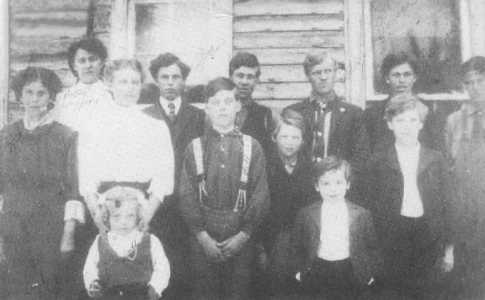
ORIGINAL LOG SCHOOL IN VERDON, BUILT IN 1898
Back Row: Polly Wiggins, Aldro Barton, Lyle Wiggins, Andrew Pearson, ? Lumen, Harlon Wells
Middle Row: Ruby Barton, Minnie Lingroth Wiggins, Bill Wiggins, Warren Wells, Sam Barton
Front Row: Ruth Barton, Bill Barton
Courtesy of Ray Barton
The Verdon Schools, #1 (Barton) and #2 (Finn or Patterson), were built by Mike Libeck. School #1, located in section 23, was built in 1916 and ran until 1943. School #2, located in section 12, was built in 1914 and ran until 1936. It was used as the town hall until the tornado of August 9, 1969 destroyed it. (Verdon Township School Reunion Book ~ 1988) School #3 (Weston) was built in 1925 by Mr. Alexander for $2,400.00. It was located in section 32 and it ran until 1945. (Letter from Curtiss and Kathy Weston)

1965 THE VERDON TOWN HALL WHICH WAS THE OLD SCHOOL
Destroyed by the tornado of August 6, 1969
Courtesy Roy Barton
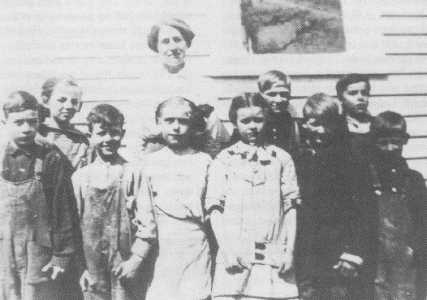
VERDON SCHOOL #1
LOCATED NEAR BARTON HOME, 1903
This school was known as Verdon #1, although it was the second school built.
Polly Wiggins, teacher, in back. Sam Barton is far right in the back row.
Ruth Barton is in front of Polly Wiggins.
Courtesy of Ray Barton

VERDON SCHOOL #2
(FINN SCHOOL OR PATTERSON SCHOOL)
This school was known as Verdon #2, although it was the third school built.
Courtesy of Ray Barton
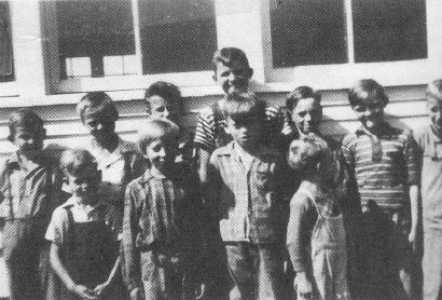
VERDON SCHOOL #3
(WESTON SCHOOL)
Back Row: Wayne Bartron, John Grimsbo, Bob Palmer, Alvin Kliewer, Carl Smith, Clifford Weston, Bill Gould
Front Row: ? Smith, Don Smith, Charles Rustad, Jim Gould
Courtesy of Ray Barton
In the southwestern part of the township lived the Weston family. Charley Weston came to Palisade in 1909 with his father, Amasa, and brother, Ollie. Amasa purchased a sawmill, and the family settled in southwestern Verdon Township. Robert Lundeen did some threshing for the area farmers. In time, Carl and Emil Paakonen got their own thresher, as well as Lyle Wiggins. (Interview with Ray and Wayne Barton ~ November 24, 1995)
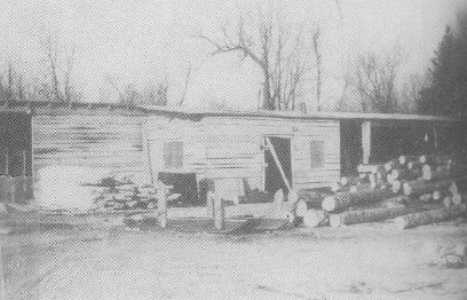
WESTON SAWMILL
Courtesy of Kevin Weston
Others logged nearby. "Mike Libeck had a large logging camp north of the Weston home in section 18. All of his timber was floated (on the Willow River) down past our place. Many men were employed and one could barely see the river for the logs were so thick and piled quite high in places." (Weston Family History dated July 17, 1993) There was another camp run by the Hill City Woodenware Company in the southwestern corner of section 6. A Mr. Kangas had a camp in section 3. (Interview of Charlie Weston by Jim Raich ~ November 17, 1996) Elmer Lane and John Jewell each had camps in the southern part of section 7. The Westons sold poles to the mines and also to Mr. Salisbury at Rabey.
Harry Riggs was an energetic man who tried to serve his community while making a living. Harry's real name was George Washington Riggs. He didn't care for that and so he went by the name "Harry." He would buy petroleum products from companies like The General Refining Company of Cleveland, Ohio. On one occasion he bought a half drum of medium motor oil, ten gallons of heavy motor oil and five gallons of Magic Motorcycle Oil. (Invoice of "The General Refining Co., dated 7/15/1922, Aitkin Co. Land Dept. Records) He would then sell portions of that order to other farmers or would have it for his own use. Harry also sold gas out of the barrel. He would ferry people in his launch and would also pick up groceries or other supplies for people on his route along the river. He had a hand crank siren to let people know he was coming. Harry ran his boat route three times a week and continued the service until the 1920's. In the winter, Harry would put skis on his Model T so he could get around in the snow. (Interview with Ernest Wiggins ~ December 5, 1995)
The Verdon area also had religious activities. "There were over 125 at Sornberger's place last Saturday. Norman Opsted brought a load up from Sandy Lake. Harry Riggs went to Mississippi with his launch and brought a load of Mississippi and Hill City people down and then he went back to Ball Bluff and brought a load down. He traveled eighty miles altogether. There were seven preachers there. They were, Higgins, Sornberger, Lowry, Burrows, Gilchrist, Hulett, and Simons. After dinner Mr. Higgins gave a good talk which was followed by a grand march and various games. The Mississippi and Hill City people had to leave early to catch the train." (Hill City News ~ August 8, 1912) The Reverend John Sornberger was the resident preacher. "Rev. John Sornberger preached at Verdon Wednesday night to an audience of forty-nine, and Saturday afternoon in Snyder's Grove to Fifty-one and Sunday near his father's place to over eighty. Five years ago he was an outcast from society, a fugitive from justice, a drunken prize fighter. truly the age of miracles is not past." (Hill City News ~ June 23, 1910)
Tragedy struck the area in 1928. "An unfortunate shooting accident took place in Verdon Township. Sunday when Jacob Mannila was instantly killed by a bullet from a gun carried by William Liimatainen. The men were out hunting and while walking along an old logging trail, Mannila was in the lead. Following closely behind was Liimatainen carrying a 32 Remington rifle into which he was pumping shells. One shell accidentally discharged, the bullet striking Mannila in the right shoulder coming out the left breast. The man died instantly. (Aitkin Age ~ December 8, 1928)
Arthur Peterson took his own life in 1933. "A coroner's jury, sitting at an inquest conducted Tuesday by E. E. Seavey in Verdon Township, returned a verdict giving the opinion that Arthur Peterson, bachelor farmer who had lived there for 10 years, had met death by his own hand. Circumstances in this recent tragedy were somewhat mysterious, for the reason that Peterson's disappearance was noted simultaneously with the burning of his barn on Monday afternoon. Neighbors saw the smoke and hurried to his place. The barn was ablaze. They could not find Peterson but in the house was a note written in farewell. The message stated that the writer was ailing and suffering intolerable pain. Sheriff C. S. Lind and Coroner Seavey, investigating in company with others, found charred bones and a barrel from a gun in the smoldering ashes where the barn had stood. It is surmised that Peterson set fire to the hay in the barn before he shot himself. Mr. Peterson was 58 years of age." (Aitkin Age ~ October 5, 1933)
Times were tough in the thirties. There was little work to be found in Verdon Township. A federal program was established for the area and was run by the National Re-employment Service, with William Wiggins as the foreman for the project. A gravel pit was opened and men were put to work graveling the area roads. Harry Riggs was the timekeeper for the crew. (Letter from Fred Ferguson, dated 1/3/1934, Aitkin Co. Land Dept. Records)
A few of the neighbors got together and established their own private telephone company. The owners were Harry Riggs, Frank Riggs, J. P. Riggs and Lloyd Wells. The power source was by battery. This line was nothing more than barbed wire strung from place to place and it was even run across the Mississippi River. The township set up their own "Public" system, and Rose Riggs became the "Operator." The system was replaced by a new one in 1945. (Interview with Ray and Wayne Barton ~ November 24, 1995) The central then went to Ball Bluff.
Verdon had an active 4-H club for a number of years. "The meeting was called to order by the president Orrel Wells at the Aldro Barton home on May 16 at 8 P.M. The pledge was given and the minutes of the last meeting read by the secretary. Twenty seven club members answered roll call by giving the work they have done on their projects. It was decided to give a pie social on June 9th to raise money for transportation to the county fair. Five cents admission will be charged. Two new members were admitted into the club. The next meeting will be held June 13, Lorraine Schendel reporter." (Aitkin Age ~ June 1, 1934)
In the thirties, the Northern Timber Company of Crosby, Minnesota set up a sawmill operation on the old Wells mill site. They went into the business of sawing up old deadheads that they pulled from the river bottom. These were logs that had sunk from the early days of the pine logging. The logs were pulled up and made into a raft that was then floated down to the mill. The logs were sawed up into railroad ties, mining timbers and other lumber. Timber was also sawed from the surrounding countryside. The finished products were hauled away by truck to such places as the mines. (Interview with Don Wells ~ December 6, 1995)
There was a pair of men on the west side of the river that owned a farm in partnership. They were Bill Liimatainen and Alex Okerman. The partnership lasted for a while, but then it went sour, and they decided to split up the farm. The line went right down the middle of the barn with the west half for Bill and east half for Alex. The rest of the farm was then also split in half.
On August 9, 1969 a great storm hit Verdon Township. It came from the west where a tornado had first touched down near Emily, Minnesota. The tornado was actually three funnels. The Finn or Patterson School was lifted up and destroyed. The Erick Hillstrom place on the east side of the river was hit hard. Erick had started a campground on the river and had plans to hold barn dances. Those plans were dashed when the storm destroyed his barn.
After the storm a new town hall was needed. The township had used the old school building for its meetings. Wayne Barton constructed a building out of logs that was made into the new town hall.
Efforts were made in recent years to revitalize the township and its facilities. Along with the new town hall, the townspeople worked on the "Meander the Mississippi" project. "Long-term plans include the marking of historic sites up and down the river, the improvement of campgrounds, parks, trails and boat accesses, an excursion river boat, and both river boat and pioneer museums." (Aitkin Age ~ date unknown) The Verdon Cemetery was the site of the first historical marker, and three posts with a rope to represent a pier were placed there.
Nostalgia reigned supreme in the 1980's as the folks got together for a couple of school reunions. One was held in August of 1980 and the other in August of 1988. It was a great time to visit and remember the "good ole days' of years past. Even some of the teachers of the one-room schools were able to make the events.
In general, the people of Verdon Township have farmed and logged over the years to make a living. It is a quiet place, and the Verdon folks enjoy the way of life they have come to know.

BACK
HOME